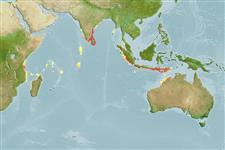Common names from other countries
Environment: milieu / climate zone / depth range / distribution range
Ecology
Marine; freshwater; brackish; demersal; catadromous (Ref. 51243); depth range 3 - 10 m. Tropical
Indian Ocean: East Africa to Sumatra, Indonesia.
Size / Weight / Age
Maturity: Lm ? range ? - ? cm
Max length : 121 cm TL male/unsexed; (Ref. 6028); max. published weight: 7.0 kg (Ref. 6028)
Adults rarely in coastal swamps, with a wide temperature tolerance. Shy and secretive, and is found in greatest abundance in mud substrates of dry zones. Most often found in deep rock pools in rivers in the wet zones. Probably feeds on small fish, crustaceans, worms and mollusks. Species is too large for use in the aquarium trade, however is a welcome food fish when caught.
Life cycle and mating behavior
Maturities | Reproduction | Spawnings | Egg(s) | Fecundities | Larvae
Pethiyagoda, R., 1991. Freshwater fishes of Sri Lanka. The Wildlife Heritage Trust of Sri Lanka, Colombo. 362 p. (Ref. 6028)
IUCN Red List Status (Ref. 130435)
CITES (Ref. 128078)
Not Evaluated
Threat to humans
Harmless
Human uses
Fisheries: subsistence fisheries
Tools
Special reports
Download XML
Internet sources
Estimates based on models
Preferred temperature (Ref.
115969): 28.1 - 29.3, mean 28.6 (based on 108 cells).
Phylogenetic diversity index (Ref.
82804): PD
50 = 0.5000 [Uniqueness, from 0.5 = low to 2.0 = high].
Bayesian length-weight: a=0.00076 (0.00037 - 0.00155), b=3.17 (3.00 - 3.34), in cm Total Length, based on LWR estimates for this Genus-body shape (Ref.
93245).
Trophic level (Ref.
69278): 3.8 ±0.57 se; based on food items.
Resilience (Ref.
120179): Very Low, minimum population doubling time more than 14 years (Preliminary K or Fecundity.).
Fishing Vulnerability (Ref.
59153): High to very high vulnerability (73 of 100).
